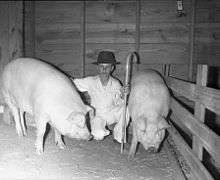Chester White
 A boy with two Chester Whites raised as part of 4-H in Texas, circa 1940 | |
| Country of origin | United States |
|---|---|
| Traits | |
| |
The Chester White is a breed of domestic pig which originated in Chester County, Pennsylvania. It was formerly known as the Chester County White.[1]
History
The Chester White was first developed around 1815–1818, using strains of large, white pigs common to the Northeast U.S. and a white boar imported from John Russell Duke of Bedford, Bedfordshire county, England, referred to as the Woburn breed, brought by Captain Jefferies of Liverpool, England.[2]
In 1848, two breeders at a county fair, one from Delaware County and the other from Chester County, showed their two breeds. The judge decided to use the name Chester County White. "County" was dropped and the breed became known as Chester White.
By 1884, a breed association was officially formed, but competing organizations, sometimes for individual strains, continued to appear into the early 20th century.
Breed associations
O.I.C.
The "International Ohio Improved Chester Swine Record Association" was formed in 1891, and incorporated in 1895, in Yates County, New York. The breed was officially named the Ohio Improved Chester with OIC commonly used. The 51-member Board of Directors included members from Maine, Texas, Iowa, Michigan, New York, Wisconsin, Connecticut, Kansas, Ohio, Illinois, Missouri, Nebraska, North Carolina, California, New Jersey, Georgia, Pennsylvania, Florida, Arkansas, Kentucky, Indiana, and Santa Clara, Cuba. The association implemented the use of ear tags as early as 1895.[3]
The Chester White Swine Record Association
In 1913, the American Chester White Record Association (1885) and the Standard Chester White Record Association (1890) combined to form the Chester White Swine Record Association.[4]
In 1930, all breed organizations were consolidated under the Chester White Swine Record Association, an act which aided the spread of the breed into the rest of the country.[5] Some historians conjecture that Chinese pigs were also added to the mix.[6]
Current
The Certified Pedigreed Swine Association (CPS) was formed in 1997, to combine the records of the Chester White, Poland China, and Spotted, into a central organization with individual state organizations being members.[7]
The Chester White is a versatile breed suited to both intensive and extensive husbandry. Though not as popular as the Duroc, Yorkshire, or Hampshire,[8] the Chester White is actively used in commercial crossbreeding operations for pork.[6] The Chester White is the most durable of the white breeds; it can gain as much as 1.36 pounds (0.62 kg) a day and gain 1 pound (0.45 kg) for every 3 pounds (1.4 kg) of grain it is fed. Their pale color leaves Chester Whites prone to sunburn; they must be given access to shade in the summer.[1]
A notable Chester White breeder is Randy Schmidt of Williamsburg, Iowa. Randy has been raising quality Chester Whites for nearly half a century and earned the breed's Distinguished Service Award in 2006.[9]
See also
References
- 1 2 Lewis, Celia (2011). The Illustrated Guide to Pigs: How to Choose Them, How to Keep Them. Skyhorse Publishing. p. 57. ISBN 978-1-61608-436-3.
- ↑ Moore, F. F. (November 1922). The Chester White Swine Record. Van Trump Co. p. 3. Retrieved October 14, 2014.
- ↑ Jones, Herbert A. (1895). "O.I.C. Incorporation". original from Cornell University. International Ohio Improved Chester Record Association. pp. 5, 41. Retrieved October 15, 2014.
- ↑ -Retrieved 2014-10-15
- ↑ "Breeds of Livestock – Chester White". Oklahoma State University Dept. of Animal Science.
- 1 2 Ekarius, Carol (2008). Storey's Illustrated Breed Guide to Sheep, Goats, Cattle and Pigs. Storey Publishing. p. 188. ISBN 978-1-60342-036-5.
- ↑ Certified Pedigreed Swine (CPS) organization -Retrieved 2014-10-15
- ↑ Dohner, Janet Vorwald (2002). The encyclopedia of historic and endangered livestock and poultry breeds. Yale University Press. pp. 175–176. ISBN 978-0-300-08880-9.
- ↑ "Our Pigs". Schmidt Swine. Traxshon. Retrieved 2006. Check date values in:
|accessdate=(help)